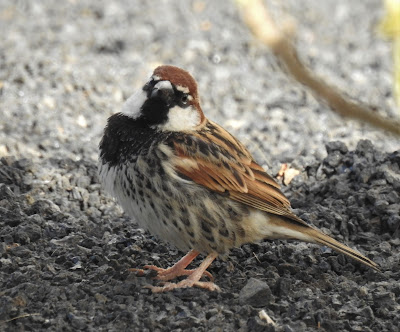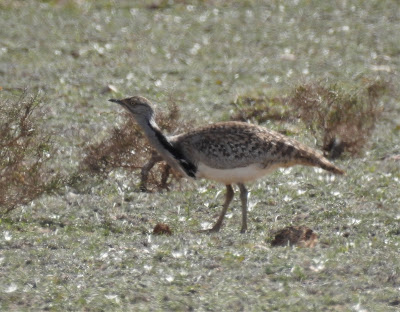Flying over the strait that passes between the cliffs of the Famara mountain range in north Lanzarote and the small island of Graciosa.
In the capital Arrecife I found a fine room by the old square, with a view over the harbour and fort. Barman Jose had a good supply of Carlos I brandy.
In the harbour Turnstones (Arenaria interpres), sporting fine splayed rufous feathers, turn stones. They were oblivious to passers-by.Spanish Sparrows (Passer hispaniolensis) live in large and noisy colonies at the base of the fronds of the palm trees lining the streets.
First trip out, to the local golf course at Costa Teguise - a green oasis.
Before a gin and tonic in the clubhouse, a walk through the greens with their black volcanic bunkers.
Scuttling around, and calling loudly, Barbary Partridges (Alectoris barbara) - a north African species introduced here.
Other birds hung around the greens. A fair number of Kestrels (Falco tinnunculus) of the eastern Canary Islands sub-species dacotiae. (ssp. canariensis is found in the western Canaries)...
...Cattle Egrets (Bubulcus ibis)...
...and White Wagtails (Motacilla alba).
Overlooking the scene a Southern (Iberian) Grey Shrike (Lanius meridionalis) of the Canarian sub-species koenigi - a 'Desert Shrike', more closely related to populations in north Africa than Europe.
Flitting overhead in the pines were Chiffchaffs. There is a Canarian Chiffchaff (Phylloscopus canariensis) found in woodlands only in the western islands. There was a sub-species of this on Lanzarote, exsul, but it is now extinct. But in winter Common Chiffchaff (Phylloscopus collybita) and Iberian Chiffchaff (Phylloscopus ibericus) migrate here from Europe. This looks like an Iberian Chiffchaff - brighter to look at, with a strong yellow stripe above the eyes, a greenish back, pale and yellow undersides, and without a strong ring around the eye. But, like a Common Chiffchaff, it has very dark legs. The only way to be really sure is by comparing their songs. The birds will recognize each other, even if we can't recognize them.And a winter butterfly, the Greenish Black-tip (Elphinstonia charlonia) - a desert species found in oases from the dry Eastern Canary Islands, across North Africa and beyond to India.
Next stop, south-east of the island to the beach of Papagayo - on a peninsula to the east of the big tourist resort of Playa Blanca.
Not much bird life of note, but a good view across to the island of Fuerteventura...
...and, fishing in the strait, Sandwich Terns (Sterna sandvicensis) - presumably over from Kent on a winter package holiday.
Behind the beach, Canary Fleabane (Pulicaria canariensis).
Driving home, through the village of Uga, I spotted a Blue-and-yellow Macaw (Ara ararauna) sitting in a tree in someone's garden - a long way from South America.
A trip up to the north-east, to the village of Tabayesco - just inland from Arrieta on the east coast. Here one can walk up the 'barrancas' that run down from the high land around the Mirador de Haria in the west.
On the dry south-facing slopes, stands of Euphorbia balsamifera - a Saharan species, which is the official plant symbol of Lanzarote.
Plenty of small birds call this home, and the air is full of their twitters. Among them, African Blue Tits (Cyanistes teneriffae), identifiable by their dark caps - instead of the light blue caps found on European Blue Tits. The populations in the western Canary Islands form distinct sub-species, lacking a white bar on the wings. Those on Lanzarote look like the populations in north Africa, with wing bars. They may be regarded as a separate sub-species, degener, or be just a population of ssp. ultramarinus from Morocco. Work in progress.
Another sub-species confined to the eastern Canary Islands - the Linnet Linaria cannabina harterti.
And, the bird that is the symbol of the Canary Islands - the Canary (Serinus canaria) (though it also lives in Madeira and the Azores).
The northern arid plains.
They can be seen from the cliffs at Famara, stretching out to the sea.
At their edge, grape vines are grown in protected cones made in the black volcanic soil. I had some good white wine produced from the Malvasia grape (but I suggest you avoid the red Listan Negro).
And here the true plain, known as the El Jable desert - home to desert birds and goat herders.
Probably the most common bird on Lanzarote, and confined to the Macaronesian islands, Bertholet's Pipit (Anthus berthelotti).
Large flocks of the Lesser Short-toed Lark (Alaudala rufescens), a desert bird of North Africa and the Middle East, will fly up as one approaches. It is very difficult to see them when grounded, such is the camouflage. Here it is the eastern islands sub-species polatzeki (there is another sub-species on Tenerife).
The flocks can be confused with those of another small desert seed-eater, the Trumpeter Finch (Bucanetes githagineus) - until they land, and show off their red bills and pink feathers. Here the Canary Islands sub-species amantum.Searching for scraps, Ravens (Corvus corax) of the Canary Islands sub-species caneriensis.
An even bigger bird, and one to be protected from quad bikes, the Houbara Bustard (Chlamydotis undulata). I was surprised to find that, despite having the whole plain to walk on, they hung around by the main road in the south. The fuertaventurae sub-species found on the Eastern Canary Islands is darker than its north African relative.
The last hour of my last day. After many hours searching on the plain, I decided to take a last look by a sheep compound I had visited earlier - and where I had and seen lots of linnets, larks and shrikes.
I heard a warbler-like chirp, and saw a small bird fly up onto a bush. A spectacular Spectacled Warbler (Sylvia conspicillata). Something so small and delicate, so ornately decorated, and with such a melodic song, on one small thorny bush in an arid sea of thorny bushes. We sat alone for some minutes, looking at each other under a setting sun. An experience alone worth the trip. It would ruin the magic with taxonomic objectivity to say that it was the Macaronesian sub-species orbitalis, so I won't. Time to go back to the humans and drink some of their beer.Afterword: The last time I visited Lanzarote was February 2007. Then I saw the Eastern Canary Gecko (Tarentola angustimentalis), endemic to the eastern Canary Islands. In this species, the sex of the young is determined by the temperature at which the eggs are incubated. Above 27C females hatch, and below males.
I took that trip in 2007 with my eldest daughter Martha and my mother, to give frail old mum some winter sun. She only lived until Christmas of that year. So this trip marks a 10 year anniversary of that loss, in a place I hope she also found some peace.
































































Great account! Interesting stuff on the subspecies, and the black headed blue tits! The Spectacled Warbler is fabulous.
ReplyDeleteThanks. Happy you found something of interest.
ReplyDelete